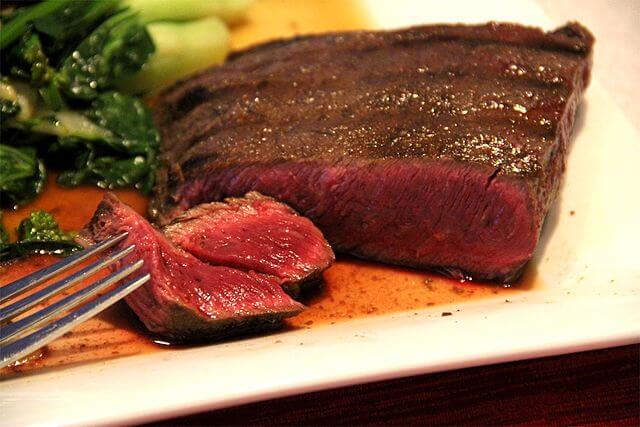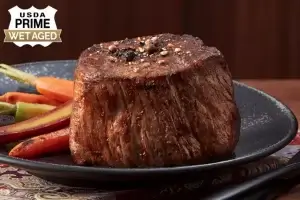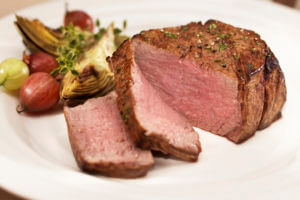
Photo by Michael Stern licensed under CC0
When it comes to the pursuit of the perfect steak, enthusiasts and amateur carnivorous connoisseurs alike will rush to tell you that medium-rare beef is best. Any more is, in fact, considered sacrilegious in many steak-eating circles. At Steak University, we tend to agree and, when given an option, will always order or prepare our steaks medium-rare.
But for the average home chef, or those aspiring foodies out there just beginning their beefy pursuits, the medium-rare steak label may seem like a mysterious creature. From the correct temperature of a medium-rare steak to how to go about cooking it, we have your answers to help attain a state of meat-induced bliss. Keep reading as we delve into everything you ever wanted to know about that transcendent state that is a perfectly cooked steak.
What is Medium Rare Steak Anyways
First, some definitions…
Medium rare steak is officially defined as steak cooked to an internal temperature of 135 degrees. 130 degrees will get you a rare steak, which isn’t a bad choice if you’re dining on a gourmet steak from a quality steakhouse or ordered from Chicago Steak Company. In appearance, steaks cooked medium rare will have a warm, red center. If you’re using the touch test method, when gently pressed in the center, medium rare steak should feel the same as pressing the space on your hand between your thumb and forefinger.
140 degrees will start to bring your steak adventures into a medium degree of doneness and the potential for tough meat and a definite lack of moisture. While medium may seem tempting, at Steak University we advise against it, since premium cuts of meat taste best at medium-rare steak temperature. And if you’re tempted to label us snobbish for our preferences, well not so fast. There’s science behind this medium-rare steak temperature madness.
The Science Behind the Temp
As it turns out, the medium rare steak’s being the most appetizing to our palates has a lot to do with the science behind the meat and less to do with personal preference. The proteins responsible for muscle contraction, Myosin and Actin for you biology lovers out there, denatures, or break down, at different temperatures. The breakdown of these proteins changes the consistency and taste of the meat. As it turns out, most people like their steaks with more Actin and less Myosin, a happy little window that magically appears right around 135 degrees, or the temperature of medium rare steak. Go figure…
Moisture is also a consideration when it comes to preference. When you cook a steak to medium-rare the internal temperature isn’t raised to a point that allows excess moisture to escape through vapor or steam, keeping your steak juicy and flavorful. Medium or, gasp, well-done steak not only exceeds the just right zone of protein balance, but it also causes moisture to evaporate from your meat, creating the potential for a chewy, tasteless disaster.
Tips on Cooking a Medium Rare Steak
So, now that we know what to do, and not to do, when it comes to the internal cooking temperature of your steak, let’s talk about how achieve the ideal temperature. We’ve gone into detail previously on the best methods for conquering medium-rare steak perfection (told you we were big fans), but there are a few basic pointers worth remembering when it comes to cooling steaks to medium-rare:
- A Meat Thermometer is your friend – A handy kitchen appliance that will be invaluable for precision cooking of just about any form of protein you can conjure out of the meat department.
- Cast Iron is King – When cooking steaks medium rare, a quick 1-2-minute sear on each side is more than enough. Finish by placing the entire pan into a 425-degree oven until desired level of doneness (cough, medium rare, cough) is attained.
- Rest is Best – While the temptation to dig right in may be real, be sure to rest your meat on a plate or cutting board for at least 5 minutes prior to enjoying. This will allow the juices to become less viscous (thin) which means they’ll be more likely to stay inside your steak once you cut into it for that first “cooked-to-a-medium-rare-temperature” perfect bite. Browse our 5-star steakhouse-quality steaks – perfect for cooking to succulent medium-rare.
Cooking Steak Medium Rare FAQs
Why Medium Rare is Always the Perfect Steak Temperature When it comes to the pursuit of the perfect steak, enthusiasts and amateur carnivorous connoisseurs alike will tell you that medium-rare beef is best. Here at Steak University, we couldn’t agree more! Medium rare steak is officially defined as steak cooked to an internal temperature of 135 degrees. In appearance, steaks cooked medium rare will have a warm, red center, and its temperature is just enough to allow enough of the flavors from the marbling to dissolve within the steak. There’s even science behind this medium-rare steak temperature madness. The proteins responsible for muscle contraction, Myosin and Actin, break down at different temperatures causing changes in the consistency and taste of the meat. As it turns out, most people like their steaks with more Actin and less Myosin, a happy little window that magically appears right around 135 degrees, or the temperature of medium rare steak. Moisture is also a factor. When you cook a steak to medium-rare the internal temperature is hot enough to allow excess moisture to escape through vapor or steam, keeping your steak juicy and flavorful. Medium or well-done steak not only exceeds the just right zone of protein balance, but it also causes moisture to evaporate from your meat. Cooking a Medium Rare Steak A Meat Thermometer– A handy kitchen appliance that will be invaluable for precision cooking. Cast Iron– When cooking steaks medium rare, a quick 1-2-minute sear on each side is more than enough. Finish by placing the entire pan into a 425-degree oven until desired level of doneness is attained. Rest is Best –Be sure to rest your meat on a plate or cutting board for at least 5 minutes prior to enjoying. This will allow the juices to stay inside your steak once you first cut into it.



